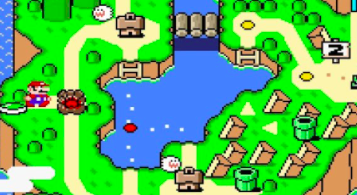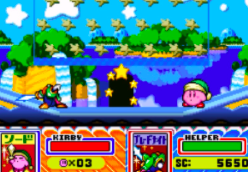Kirby games are often described as an embrace of capitalist systems. Players are rewarded for consuming items and enemies to gain powerups without regard for Kirby’s health or the well-being of those around him. Kirby is a pure hedonistic machine inhaling everything in his path. However, in this post, I want to argue that the evolution of mechanics in Kirby games reflects sentiments by the Japanese public towards free trade and the stability of the nation’s economy. Cooperative gameplay introduced to the series in Kirby Super Star underscores a growing disillusionment with traditional neoliberal practices and the embrace of a more cooperative economic structure.
To begin analyzing the Kirby titles, we need to go back to 1992, when the first Kirby game, Kirby’s Dreamland, was released. From the close of the Second World War to the early 1990s, the Japanese economy underwent massive growth that translated to improvements in standard living conditions. Dubbed the “Japanese economic miracle,” the size of Japan’s economy grew tenfold over a 40-year period with steady GDP growth above 9% annually. However, by the end of the decade, the Japanese economy had stalled for a host of reasons, dragging down wages and slowly reducing the size of the middle class.
At the same time, Kirby Super Star was introduced as one of the first Nintendo games to include cooperative multiplayer gameplay. Preceding games like Super Mario World that contained multiplayer options did not allow simultaneous gameplay. Instead, players would take turns to beat a level, without any significant interaction between their characters. No items are shared, even though players have the options to store additional items in reserve. Thus, interaction only occurs on the overworld map, as advancements made by one player are shared by both.

Cooperative multiplayer games, in comparison, allow players to work as teammates, attacking simultaneously and sometimes sharing items. Kirby Super Star accomplishes this by introducing the helper system, which changes how players use their powerups. Most importantly, this system encourages resource sharing where players would otherwise be inclined to keep items for themselves.
Whenever Kirby enters a level and swallows an enemy, Player 1 is granted the opportunity to give up the power so that a helper can be created. Helpers resemble the enemies Kirby swallowed, in essence being converted to join as an ally. Some new Kirby games like Kirby Star Allies build on this concept by having Kirby throw hearts at enemies, converting them to his side as friends.
Other cooperative mechanics also present players with trade-offs to consider when playing with a partner. When a partner player wants to change their power-up, the Kirby player must give up their power once again to throw it to their teammate. The helper, unable to change their own power must rely on the charity of Kirby to improve their character. Moreover, when Player 2 runs out of health, Kirby can give up their power to save their teammate. Again, giving up Kirby’s power to help a teammate comes with important considerations. In boss fights, it can be difficult to acquire new powers as Kirby, and certain preferred powers are not guaranteed to reappear soon afterward on the normal level. Nonetheless, the advantage to having a second player normally outweighs the benefits of having a preferred power. Thus, gameplay forces players to realize that effective teamwork can require mutual, small sacrifices to uplift one another.

Finally, when Kirby eats a food item and walks next to a helper, the partner will restore health equal to the item that was used. Rather than promoting fierce competition for scarce healing items, this mechanic ensures that players willingly share materials amongst each other.
All of these mechanics use the limited resources available to players, whether power-ups or healing items, to encourage coordination as opposed to the single-track consumption present in earlier Kirby games. Eating enemies and items still create boons, but the gains from these resources are now in the public domain, prompting careful consideration for their consumption and ownership.
Taken together, the game’s focus on sacrifice for communal benefit pushes back on traditional conceptions of unregulated capitalism. In domestic and international markets, neoliberalism presumes that unregulated competition breeds productivity and growth. As inefficiencies in the economy are culled, initially limited resources can be cultivated to grow overall production. Yet by promoting player cooperation, Kirby Super Star highlights the capacity for individuals to use limited resources in another manner. Those with greater control over resources, such as the Kirby character, have inherent incentives to uplift “helpers” in the rest of the economy to improve coordination and streamline economic responses.
The plot of Kirby Super Star also reflects dissatisfaction with neoliberal systems by objecting to the continual drive for increased productivity. In the game mode, “Revenge of Meta Knight,” Kirby is tasked with stopping Meta Knight’s takeover of Dreamland to eliminate laziness among the region’s residents. Kirby must destroy Meta Knight’s airship and military infrastructure before Dreamland is subjugated to his will. Here Meta Knight is cast as the villain for imposing his demands for productivity on the populace. The military-industrial complex, represented by Meta Knight’s airship, is seen as a catalyst for these increasing demands.
In short, the economic downturn in Japan during the 1990s caused game designers in Nintendo to reconsider their perspectives on capitalism and consumerism. Kirby Super Star does not stray too far from its roots, with consumption remaining a key mechanic in the game. Nonetheless, the addition of the helper system and story elements in the Meta Knight game mode reveal concerns about overconsumption and overproduction. Players are encouraged to consider new strategies that promote teamwork, even if doing so creates greater demands from those with more resources. An economic system that promotes collective gain, through welfare systems or other wealth-sharing mechanisms, may be a future that Kirby game designers envisioned for Japan.
Sources:
https://wikirby.com/wiki/Face-to-Face
https://www.mariowiki.com/Item_Storage
http://laits.utexas.edu/~mr56267/HIST_341_materials/Pages/Postwar_Economy.html
https://en.wikipedia.org/wiki/Cooperative_video_game#Arcade_co-op_gaming


I find it super interesting that a game from so long ago could have plot points that are relevant today. I really like the message of the Revenge of the Meta Knight gamemode, especially considering how often “laziness” is portrayed as a very negative thing in today’s society – The constant drive for people to be productive and useful to the economy is incessant and annoying. Did similar anticapitalist messages stay in subsequent Kirby games or did was it rooted out? Do Kirby games reflect Japan’s economy or the world economy still?
I appreciate the differences you made note of in the multiplayer modes between Super Mario World, where progress happens between Mario and Luigi in separate states, and Kirby Star Allies, where it happens together. Can you make an argument that Super Mario World also encourages a sort of sharing of resources to progress, just that it happens sequentially? Like one brother lays the groundwork for the other to get slightly farther ahead by setting checkpoints and getting items? It does feel more contained, though, as if the resources being shared are being done in a matter similar to inheritance, where only the receiving party can directly benefit from it.